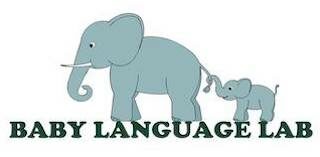For a description of our current research studies, click here.
Preference
A common procedure we use in the lab is called the Headturn Preference
Procedure. In this procedure, a set of words or sounds or sentences is paired with a visual display. Whenever the baby looks toward the visual display, the sound plays. We can then measure a baby’s interest in what they are hearing by how much they look toward the display. Sometimes we are interested in measuring the interest that a baby brings into the lab. For example, we can compare how long a baby listens to we can compare how long a baby listens to speech that was intended for babies (“infant-directed speech”) with how long they listen to speech that was intended for adults (“adult-directed speech”). Other times, we play words, sounds or sentences for the babies for a while and then test their preferences for new sounds based on what they just heard.
Habituation
Every time we say a word or sentence, it sounds little bit different. Sometimes these differences are not meaningful. For example, we never say the sound /b/ as in “bat” exactly the same way twice. Babies need to learn that all these different versions of /b/ are the same sound, or category of sound. Other times, the differences are meaningful. For example, the melodic tune that we use in asking a question like “Is today Thursday?” is different from how we would say “Today is Thursday.” Babies need to know about these differences. When they treat the two different kinds of sounds as different, we say they discriminate the sounds. In order to test babies’ discrimination of different sounds and melodic patterns in speech, we use a procedure known as habituation. Like the Headturn Preference Procedure, we use a visual display to gauge the babies’ interest in what they hear. In Habituation, however, infants hear a series of sounds, words or phrases repeated many times. Eventually, the infant becomes bored with the sounds and starts to look less and less at the display in order to hear the sounds. When this happens, the testing begins. Infants will then hear new sounds, some of which are the same as the sounds they have been hearing. Others are a different sound or sound category. By measuring how interested they are in the new sounds by how much they look toward the monitor, we can learn whether infants discriminate these sounds or sound categories.
Recording
When studying how infants learn language, it is important to examine one key aspect of that development — the language they are hearing. In our lab, we have a variety of different studies looking at the properties of the language infants hear and how that helps them learn language. Some of these studies involve coming into our lab and readings sentences into a microphone, either with or without your baby present. We then perform acoustic analyses on the properties of your recording. We may also use your recording (with your permission, of course!) in future studies with infants in the lab. Other studies involve bringing home a sophisticated recording device called a LENA device and doing day-long recordings of the natural language environment your child during a typical day. These recordings are then brought back to the lab and analyzed for a variety of language and acoustic characteristics. Other studies involve video-recording brief play sessions in the laboratory between you and your baby.
Caregiver Report Questionnaires
Another way we collect information for our studies is through caregiver questionnaires. These questionnaires will ask you to reflect on characteristics of your infant’s development (e.g. a checklist of the words your child knows or says), your child’s overall experiences in the home (e.g. what languages they hear) or aspects of your own experiences (e.g. how much stress you experience as a parent).
